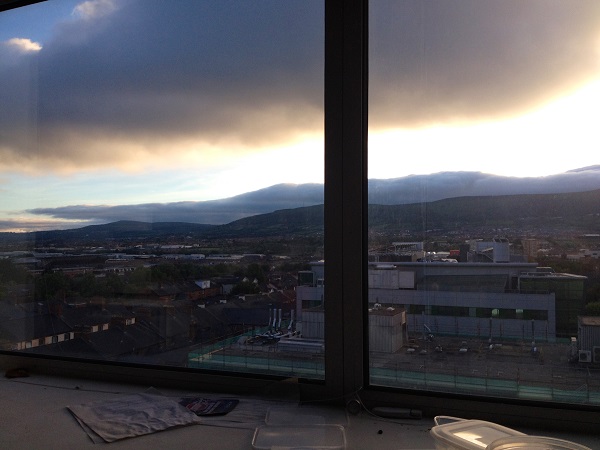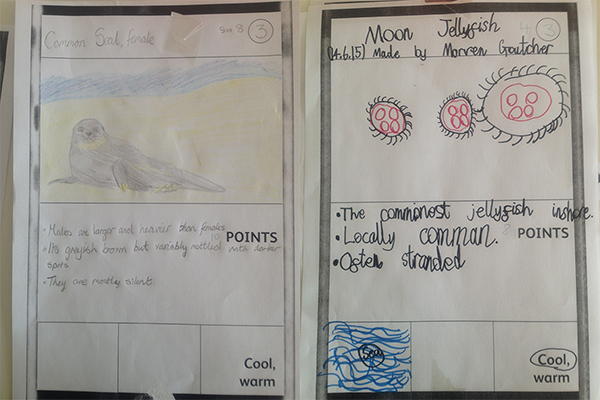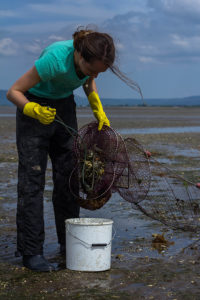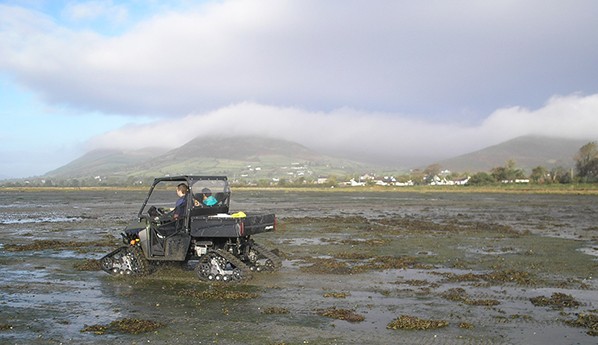For more information read Lydia’s non-technical PhD summary.
October 2015

Final year… After my final sampling campaign in Carlingford in April I spent about two months in the lab analysing my remaining samples. Identifying those last few samples from the sediment cores has been somewhat of a surreal experience. It was a reminder that my lab and fieldwork was finally coming to an end, and that the final year of my PhD is looming over me.
At the same time, having finished field work and lab work came as somewhat of a relief, allowing me now to fully focus on my analysis and write up. Writing is a habit to get into, and I am starting to feel that it is becoming easier. Analysis has been quite challenging. Estimating the abundance of mobile species such as crabs caught in our nets on a square meter basis, for example, has been giving me quite a headache over the past few weeks. But I feel that I am learning many valuable skills and analysis techniques that I will be able to use in the future.
After a few months in front of the computer, I am now starting to miss the lab work and being in the field. Although lab work could be tedious at times, I enjoyed the wide views across Belfast during lab breaks and the challenge of identifying polychaetes whilst listening to music or Harry Potter audio-books. Fieldwork is an adventure; the unpredictability of sunshine and rain, not knowing what you will catch and the fresh air. But when I feel like that I remember that sitting at my office desk in the warmth surely is the nicer place to be than a cold, rainy mudflat.

July 2015
I had the opportunity to create a marine biodiversity card game, which follows the Phylogame model. Phylo is a free, open access card game developed by David Ng, who felt that children nowadays are more likely to know different kinds of Pokémon than biodiversity. Different decks can be downloaded online, ranging from coral reef to dinosaur deck designed by professional artists, public and even school classes.
A colleague and myself decided a marine biodiversity game was missing and developed a marine version including a range of important species and human impacts; Marine Phylo.

The Glasgow Science Festival offered us with the perfect opportunity to test our game across a range of ages, from adults to young children. Marine Phylo can be played with younger children as top trumps. The advanced game is based on creating food chains and food webs, and trying to sabotage the opponent’s webs.The great thing about Marine Phylo is that does not require any knowledge of marine habitats.
We received overwhelmingly positive feedback, and had a great time playing the game with visitors during the Science Sunday Event. Being marine biologists turned out to be of no advantage and we lost surprisingly often.

Interested? Download the set Marine Phylo card set and rules.
March 2014
As part of my PhD I am sampling Carlingford Lough mud flats every two months over the course of one year, investigating how food webs change. I am interested in understanding if food webs expand and contract during the seasons, and what that means for the processes that occur within the mudflat ecosystem.

So far I have visited Carlingford Lough five times, with next week being my final field campaign. I am using 12 fyke nets at four spatial scales to sample larger mobile animals and sediment cores for smaller macrofauna in the mud. This will allow me to understand spatial and temporal changes of these coastal food webs.
The temporal differences we have seen so far found are quite astonishing, even without having analysed the data. We had high species diversity and biomasses in our nets during the summer months up until October. In winter we found lower species richness and biomass, with most nets being empty. Sediment cores were dominated by polychaete worms at all times, although we found lower abundance in the winter months. I am looking forward to the sampling next week. I think we will see an increase in the number of species and biomass as summer approaches.

Without the help of the Loughs Agency and their equipment, doing this fieldwork would’ve been quite a challenge. I would like to thank them here. I am looking forward to discussing the results of this work with them, hoping they will find them useful.
October 2014

I have been busy identifying my sediment core samples from my Northern Ireland sampling campaigns. It can get tedious at times, but I am using the School of Biology’s camera microscope, which makes things much more interesting and allows me to capture some good shots of the macrofauna in the cores.
I have also started to plan my sampling campaign at the end of October. I am hoping that Scott Pedley, the CBESS ecoinformatics postdoc, will be able to join me to get an idea of what sampling and field campaigns can be like.
I have had the opportunity to present my stable isotope work at the International Stable Isotope Conference in Perth, Western Australia. I also gave informal talks at Sydney University and the Fish Ecology Group at the University of Western Australia. These were great opportunities to discuss my work, enabled by funding from the Fisheries Society of the British Isles and Sarah Emily Montgomery studentship.
Currently, my supervisor Prof Mark Emmerson and I are writing up another grant proposal allowing us to analyse the Morecambe Bay isotope data set.
I have also been able to present my work at the Natural History museum of London Science uncovered event, allowing me to engage the public with my work on intertidal mudflats.
April 2014
I am still measuring the remaining samples from the field campaign to estimate abundance and biomass of the Fyke net catch, and getting my isotope samples processed and ready to send off to the NERC stable isotope facility in East Kilbride.

We have received NERC funding to process 1300 tissue samples to investigate energy flow and trophic characteristics in the Essex and Morecambe mud flats using stable isotopes. So far I have processed about 400 samples – clearly there is still a lot of processing to do!
Having processed my shore crab samples, I went to visit the isotope facility earlier this year. Jason Newton, who is helping me analyzing the samples, gave me an introduction to the facility, the elemental analyzer and the mass spec and, after some training, allowed me to run my own samples, which was very exciting.

I have also started to look for additional sampling locations. I am hoping to sample sites with sediment characteristics between those of Morecambe (sandy) and Essex (muddy) – sandy-mud essentially.
With my supervisor, Mark Emmerson, I have been visiting Carlingford Lough and Lough Foyle, both of which are very much what I have been looking for. The Loughs Agency – the location managers – are incredibly helpful and will support our sampling campaign, which is like to go ahead in May/June. My third sampling location will likely be Belfast Lough.

January 2014

I am currently working through the samples which were collected during Essex and Morecambe field campaigns. Because of the very long and challenging field days we had little time to process the fyke net catches in the field. Therefore I am identifying, drying and measuring my specimens (a smelly affair) at Portaferry Marine Lab now.

I am going to characterize food webs using abundance and biomass of all species and individuals caught in the fyke nets deployed by the Queen’s University Belfast team during sampling last year. After catching very little during the sampling campaign in winter, we had much greater catches during the summer.
Working through my samples I have now finished Tillingham Marsh and Abbotts Hall, both dominated by the shore crab, Carcinus maenas. I have measured 2,017 crabs so far, ranging from small individuals of only 1.2g to very large crabs of up to 50g dry weight.
Once I have finished the Essex samples, I will be moving onto Morecambe, where the catches were dominated by the European flounder (Platichthys flesus). In addition to drying and weighing these samples, I will also work on stomach content analysis, which will give me an understanding of the diet of these fish.
When not working at the Portaferry Marine lab I am also processing stable isotope samples from muscle tissue of the organisms caught during sampling season.

Stable isotopes can be used as a means of inferring diet of an organism and will form an important component of my PhD. I am currently grinding and acidifying tissue samples, which eventually will be processed in the NERC stable isotope facility in East Kilbride. With over 2500 samples to process I have a long way to go…..
